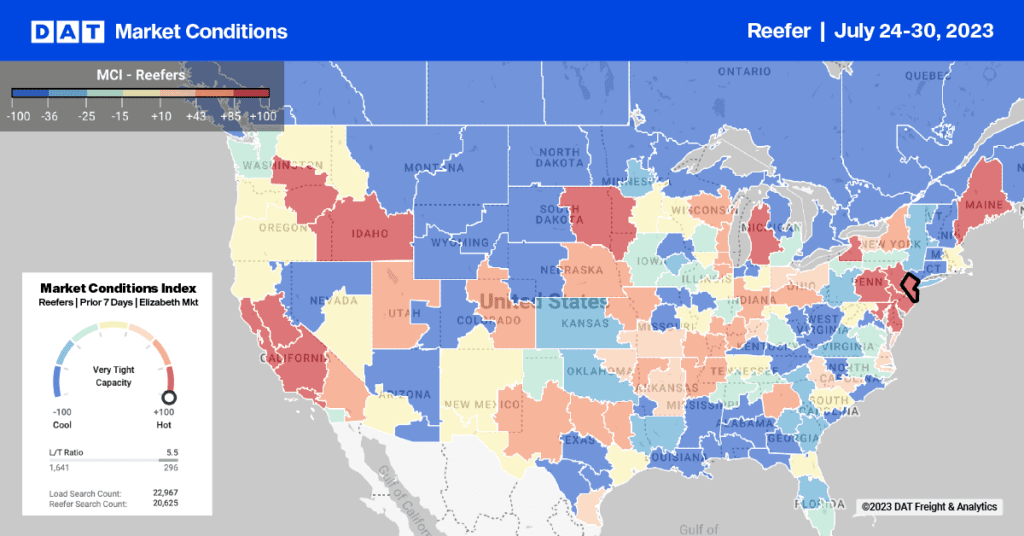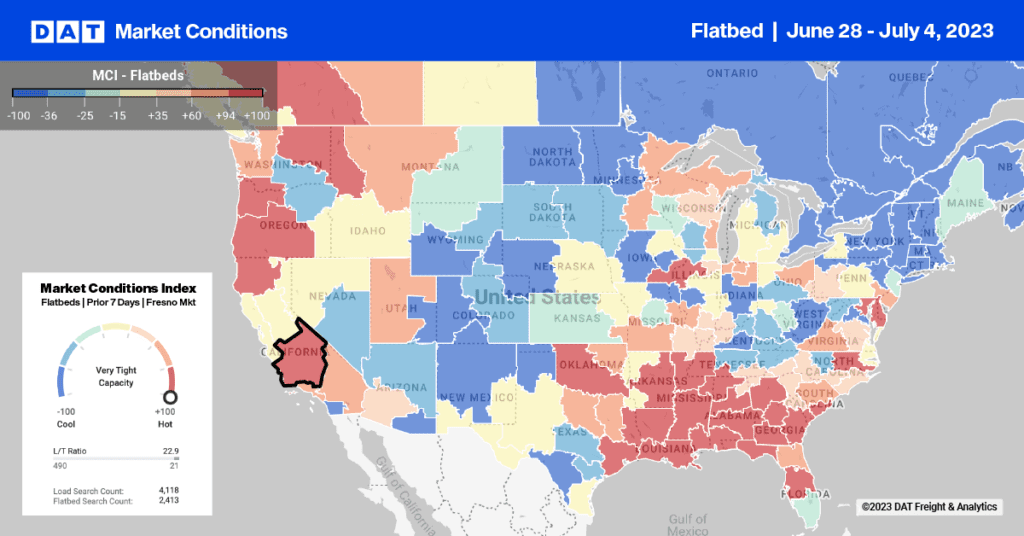The latest week of load and truck posting volume indicates a slowdown of activity on the spot market. Load postings declined 11% but have generally been well ahead of last year. We seem to be in an inconsistent pattern, though, up one week, down the next. There is no unified narrative, as some industries like autos and lumber are doing well and others like steel and manufactured goods are down.
Van
Van shipping slipped sharply last week, and national rates dropped by 0.9%. In major markets*, rates were helped by California outbound rates, so the total decline averaged to only 0.3%. Atlanta, up 0.5%, continued a pattern of reversing rates as surrounding areas soften. The Stockton, CA market also rose 0.5% as a late harvest plus port activity kept volumes strong and supported the rates. Memphis had been the bright spot in prior weeks, but rates declined $0.09 per mile overall on the lanes sampled. Chicago slipped by $0.07 per mile, as well. Other markets with rate declines last week of more than 2% included Seattle, down 3.1%, and Columbus, off by 2.4%. Load volumes were down noticeably for the week ending October 13, especially in the East.
Reefer
Reefer rates have been falling since mid-September, despite some signs of tight capacity in this segment. The latest week of data shows rates down 1.6% from the previous week on 6.7% lower volumes. Overall, 25 lanes rose while 32 declined and 7 were neutral in the top 64 lanes. Atlanta slipped 4.2% as the third quarter peak recedes. Phoenix, Denver, Fort Worth, Sacramento , Fresno and Lakeland all moved lower by at least 2%, contributing to a nationwide trend of declining rates. Only Grand Rapids, MI ran counter and that is largely driven by the apple crop which was much smaller than usual this year. Atlanta and Phoenix both saw market averages decline by $0.08 per mile versus the prior week.
Flatbed
We’ve seen a sharp dip in load-to-truck ratios for flatbed on a nationwide basis. Regionally, the Pacific Northwest and most markets in the Southeast remain robust. Lumber and auto parts are moving in quantity. What has changed is that steel shipments are down. Spot market rates remained strong for flatbeds throughout the third quarter, but they are starting to slip now in October. A lot of the current high-demand areas are not volume leaders. Houston is the largest flatbed market by far, followed by Atlanta, Baltimore, Cleveland, Savannah, and Memphis. Only Memphis and nearby markets like Decatur, AL and Little Rock, AR are “hot,” among the top markets.
Flatbed remains the most lucrative segment of trucking in 2012. I believe that capacity has been creeping back, based on our growing number of truck posts, which will moderate rates. Housing having turned the corner is a huge boost and accounts for the weak results in Florida as inbound materials creates a glut of flatbed capacity. Rates in flatbed are still close to contract rate levels so I suspect rates will continue to slide until March 2013.
* DAT has defined 135 markets in the US and tracks the top 12-15 by equipment segment in addition to national rates. Those markets include Atlanta, Buffalo, Charlotte, Chicago, Columbus, Dallas, Denver, Houston, Los Angeles, Philadelphia, Memphis, Phoenix, Salt Lake City, Seattle, and Stockton.


